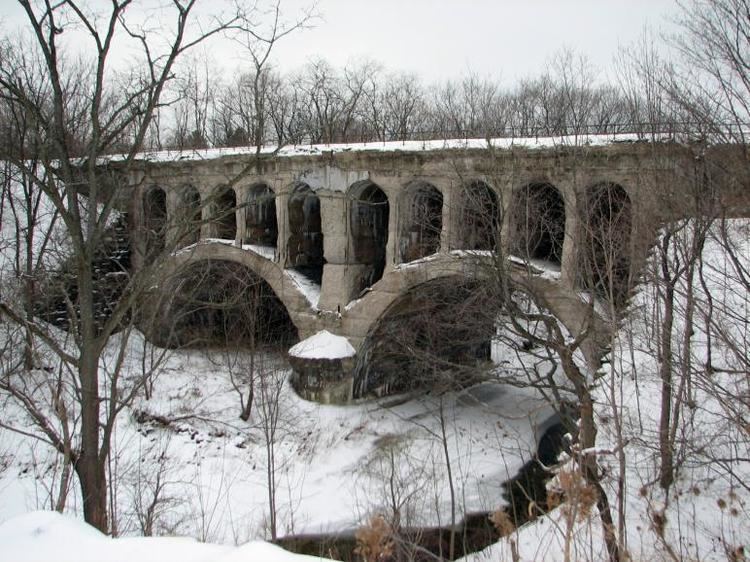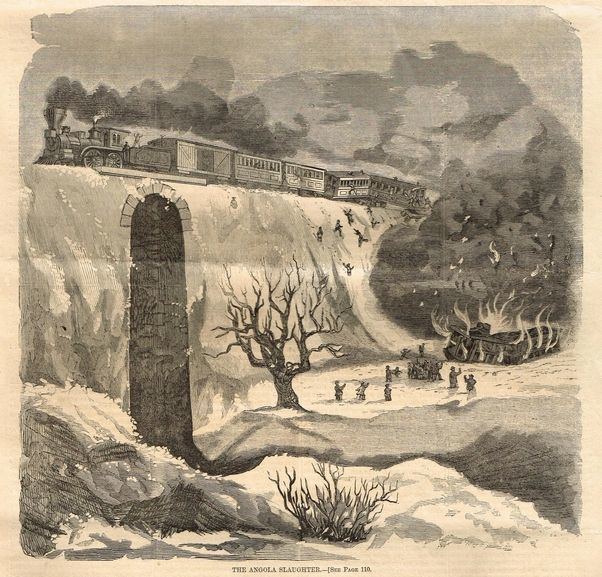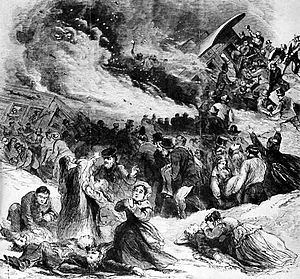Date December 18, 1867 Rail line Lake Shore Railway | Time 3.11 pm Country United States | |
 | ||
Operator Cleveland, Painesville and Ashtabula Railroad | ||
The Angola Horror train wreck occurred on December 18, 1867, just after 3 p.m. when the last coach of the Buffalo-bound New York Express of the Lake Shore Railway derailed at a bridge, slid down into a gorge and caught fire in Angola, New York, killing approximately 49 people.
Contents

Angola horror at ehs 3 24 14
Train

The express left Cleveland's Union Terminal at 6:40 that morning and was due to arrive in Buffalo at 1:30 p.m. John D. Rockefeller planned to make the journey, but arrived a few minutes late. His baggage made it onto the train; he did not. That day the train consisted of four baggage cars, one second class car and three first-class cars. Each wooden passenger car had a pot-bellied stove at each end to provide heat, and kerosene lamps for light. The train lost time on the journey. By the time it passed Angola, it was running two hours and forty-five minutes late, traveling rapidly to try to make up lost time. Its last passenger stop before the accident was at Dunkirk. It also stopped at Silver Creek, but only to take on wood and water.
Accident

The train was formed of so-called 'compromise cars,' which were designed to allow freight trains to run on both the 4 ft 8 1⁄2 in (1,435 mm) standard gauge of the New York Central Railroad as well as the 4 ft 10 in (1,473 mm) Ohio gauge of the Lake Shore Railroad. This allowed 3⁄8 inch (9.5 mm) lateral movement on the Ohio gauge and created instability. As the train neared the truss bridge over Big Sister Creek just east of Angola at 3:11, it ran over a 'frog' (the crossing point of two rails). The front axle of the rear car was slightly bent, and the frog caused a wheel on the defective axle to jump off the track, derailing the rear car, which then swayed violently from side to side. The brakes were applied, but the train still traveled at considerable speed as it crossed the bridge. The last car uncoupled from the train and plunged down into the icy gorge. The second-to-last car also derailed, but made it to the other side of the gorge before sliding 30 feet (9 m) down the embankment. Only one person was killed in this car.
Deaths
The passengers in the last car were not so fortunate. The car plunged 40 feet (12 m) down the ice-covered slope to the gully bottom and came to a rest, at a 45 degree angle, with a fearful crash. The passengers were thrown together at the end of the car onto the overturned stove. The stove from the other end of the car fell upon them and released hot coals. The carriage immediately caught fire, the fuel from the kerosene lamps fueling the flames. Only two people escaped alive from the carriage; some may have suffocated, but the majority were burned alive. Witnesses spoke of hearing the screams of those trapped inside lasting for five minutes.
Reporting
The accident, dubbed the 'Angola Horror', gripped the imagination of the nation. Accounts of the tragedy, accompanied by grisly illustrations, filled the pages of newspapers for weeks, and showed the tragedy of those trying to identify their loved ones among the charred remains that were pulled from the wreckage. Frank Leslie's Illustrated Newspaper carried five sketches of the scene and concluded "This railroad disaster is accompanied by more horrible circumstances than ever before known in this country, and its results are truly sickening to contemplate".
Aftermath
The accident and the public outcry that arose from it influenced many railroad reforms that soon followed, including the replacement of loosely secured stoves with safer forms of heating, the replacement of wooden cars with iron, more effective braking systems and the standardization of track gauges.
Dramatization
The accident was featured on the History Channel television series The Men Who Built America, and explained more in detail how John D. Rockefeller missed the train. The depiction of the accident incorrectly portrays the entire train derailing, and not just the last two coaches as actually happened.
Memorial
In 2008, the villagers of Angola erected a sign to mark the site of the accident, dedicated to its victims. It is planned to erect a second memorial to at least 17 unidentified victims buried in Forest Lawn Cemetery, Buffalo.
